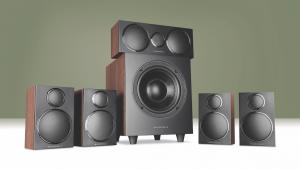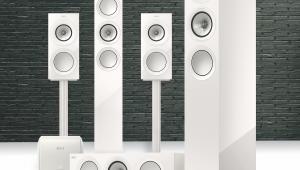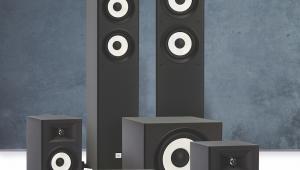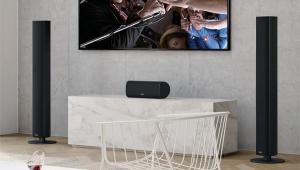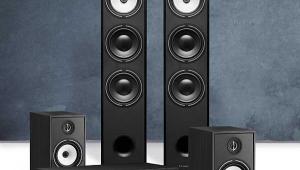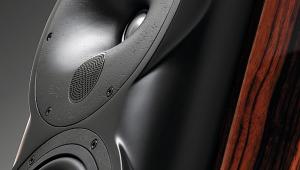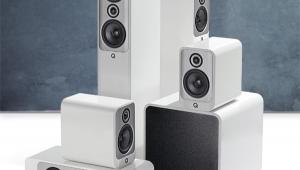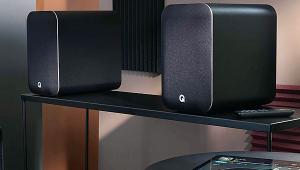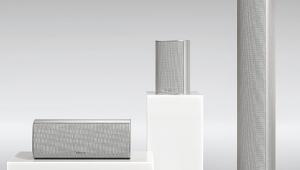Bowers & Wilkins MT-60D review
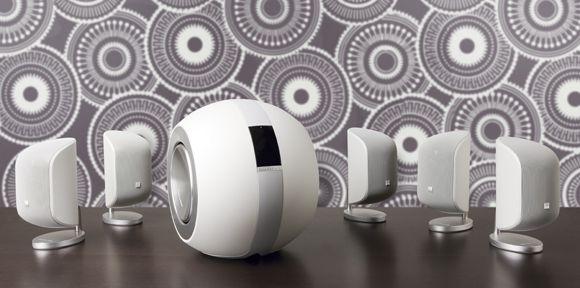
I was fortunate enough to audition Bowers & Wilkins’ first PV1 subwoofer and M-1 Mini Theatre speakers. At the time, my lad was just a boy (now he is man-sized) and even he said, ‘Dad, they’re just clearer than the others,’ as they wiped the floor with their assembled rivals.
The PV1 was the brainchild of one of the brand’s engineers, out for a walk in the South Coast town where B&W is based. He spotted a one-metre aluminium sphere bobbing in the sea – a marine buoy. He thought the material and the shape would make a theoretically perfect enclosure for a subwoofer. Now, I would swim in the English Channel naked on Christmas Day to have been privy to the original one-metre prototypes, but the PV1 was still bonkers by the time it ended up as the football-sized cult seller of low-frequency grip and performance that we all know and love.
Likewise, I was as impressed as my boy with the M-1 – and would say so when asked by relatives and friends as to what’s the best of the smallest speakers around.
And now, they have been re-engineered. I hate it when companies over-egg what they have done; when this year’s model is mostly a cosmetic tweak or else a quick fettle of the internal crossovers. This new speaker isn’t that at all. It’s a total step change. Little to see, lots to hear.
Time to fiddle
The new M-1 does look pretty much the same, though. I grumbled at the fiddly speaker connection, but that’s something only reviewers care about. Owners will lovingly install them once – not twelve times a year or more. But the thing is, it was a faff. The concept of hiding the connection within the stem of the integral bracket is still brilliant, though, and what you now find under the easy on-off base piece is a pair of spring-loaded squeeze connectors for a decently fat bare wire.
Each M-1 arrives with a stumpy wall bracket as well as the bigger foot, and with the included wrench key you can loosen the back and replace it at 90 degrees to use the speaker sideways as a centre. B&W also sells an optional stand for ‘tower’-style use.
The drivers are special. Hiding under the grille is an aluminium high-frequency dome that is rear-loaded with a tube, like the brand’s Nautilus speaker, and the woven glass fibre midbass driver now sports an anti-resonance plug, borrowed from B&W’s PM1 speaker. That, and a lower crossover point for the tweeter, make for a speaker that may look the same but has more grunt, impact and audio audacity.
The evolution of the original PV1 sub to the PV1D is even more involved. It has a bigger enclosure and hi-tech new drivers. You might describe it as dual-headed Hydra of metallic bass. I certainly do.
The front provides a panel that requires a gentle stroke for the OLED display inside to burst into life. From here you can delve into the sub’s EQ settings and presets, or else download Bowers & Wilkins’ SubApp and do it on a laptop on the sofa (a long wire is provided). This simply duplicates all you can do through the panel. Setup, derived from the B&W DB1’s platform, might at first seem difficult but is actually a doddle.
To give a speaker system a full review, you have to play a few different sources and watch a number of flicks all the way through to have a solid clear idea about their ultimate performance. Likewise, to live with them and feel how they improve a little as they run in is fascinating. But at the same time, the immediate basic performance that a system hits you with is equally important. In truth, you will be forming nearly all of your opinions in the first ten seconds. First impressions count – and the B&W array impressed from the word ‘go’.
What happened when I first fired these up, with a bit of Peter Gabriel musical mayhem from a demo disc, was wonderful. My mind was momentarily boggled. For not only do these small, smart-looking enclosures pack amazing, sweet-sounding tweeters, the new fibreglass midbass drivers reach down to 64Hz, and said tweeters are also crossed-over lower down, too. What this means is that the midband – right where Peter sings and rasps – is amazingly clear and the lower midbass snap is similarly effective. And, with the rich and tight output of the PV1D subwoofer seemingly nailed to each small satellite, you’ll feel you’re surrounded by big cabinets with ultra-fast drivers.
Film-wise, The Hangover and The Hangover Part 2 were my BD fodder of choice and the B&W system’s handling was superb. A major slice of these movies’ sound design is dropping big bass-heavy music into the action with room–shaking boom, way above the dialogue level. This is a challenge for such small speakers as you are asking for low-end impact, scale and, above all, vast dynamics – yet somehow the MT-60D set delivers.
In the sequel, which is far darker than the original, there is a shooting of horrible realism; the gunshot tears the laughter right out of your throat, such is the impact. The downward reach of the fibre cones is breathtaking, and the subwoofer is so tight, deep and implacable, that it, too, seems to be bigger than its enclosure make feasible.
Small details aren’t ignored either. In the first movie, a very real and growly tiger ends up in the bathroom of the protagonists’ suite. Its roar is high in the mix, yet when Zach Galifianakis’ dimwitted character blunders in to relieve himself, you can cleanly hear him stop, mid-flow, as he turns around in horror. The resolution is exquisite – these satellites lap up subtle effects with relish.
The MT-60D system is designed to fit into homes, rather than homes fitting around it – as you would a pair of B&W’s Nautilus flagships, or a THX Ultra2 system such as Jamo’s D 600. They are pretty and unobtrusive, more self-effacing than bling (although the subwoofer does have a slice of pure desirability about that’ll surely make it as huge a seller as its forebear). But beyond the looks and pursuit of domestic harmony, the MT-60D is also about sheer performance. Yes, you are paying more than you would for most sub/sat arrays (if the subwoofer in particular seems steep, a more affordable B&W package utilises the ASW608) but this setup is the business. It’s startlingly potent for the size, with blistering dynamics and a purity and soundstage that equals and surpasses a lot of its more expensive rivals.
It is therefore heartily recommended. If you want small, gorgeous and astonishingly good and have the money, then these are the speakers of choice for your cinema room.
HCC VERDICT
Bowers & Wilkins MT-60D
Price: £2,000 Approx
www.bowers-wilkins.co.uk
Highs: High performance for small speakers; delicious scale and imact; lavish looks
Lows: Premium price tag; connections are a bit fiddly
Performance: 5/5
Design: 5/5
Features: 4/5
Overall: 5/5
Specifications
MT-1 satellite speaker
 |
Home Cinema Choice #351 is on sale now, featuring: Samsung S95D flagship OLED TV; Ascendo loudspeakers; Pioneer VSA-LX805 AV receiver; UST projector roundup; 2024’s summer movies; Conan 4K; and more
|




